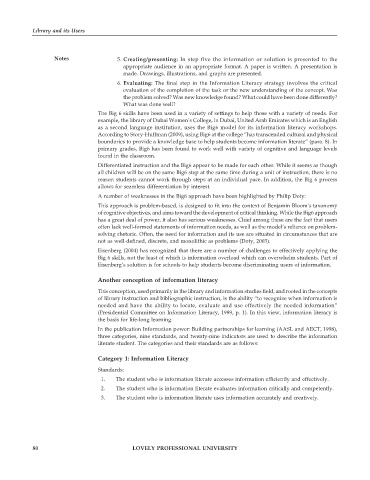Page 85 - DLIS102_LIBRARY_AND_ITS_USERS
P. 85
Library and its Users
Notes 5. Creating/presenting: In step five the information or solution is presented to the
appropriate audience in an appropriate format. A paper is written. A presentation is
made. Drawings, illustrations, and graphs are presented.
6. Evaluating: The final step in the Information Literacy strategy involves the critical
evaluation of the completion of the task or the new understanding of the concept. Was
the problem solved? Was new knowledge found? What could have been done differently?
What was done well?
The Big 6 skills have been used in a variety of settings to help those with a variety of needs. For
example, the library of Dubai Women’s College, in Dubai, United Arab Emirates which is an English
as a second language institution, uses the Big6 model for its information literacy workshops.
According to Story-Huffman (2009), using Big6 at the college “has transcended cultural and physical
boundaries to provide a knowledge base to help students become information literate” (para. 8). In
primary grades, Big6 has been found to work well with variety of cognitive and language levels
found in the classroom.
Differentiated instruction and the Big6 appear to be made for each other. While it seems as though
all children will be on the same Big6 step at the same time during a unit of instruction, there is no
reason students cannot work through steps at an individual pace. In addition, the Big 6 process
allows for seamless differentiation by interest.
A number of weaknesses in the Big6 approach have been highlighted by Philip Doty:
This approach is problem-based, is designed to fit into the context of Benjamin Bloom’s taxonomy
of cognitive objectives, and aims toward the development of critical thinking. While the Big6 approach
has a great deal of power, it also has serious weaknesses. Chief among these are the fact that users
often lack well-formed statements of information needs, as well as the model’s reliance on problem-
solving rhetoric. Often, the need for information and its use are situated in circumstances that are
not as well-defined, discrete, and monolithic as problems (Doty, 2003).
Eisenberg (2004) has recognized that there are a number of challenges to effectively applying the
Big 6 skills, not the least of which is information overload which can overwhelm students. Part of
Eisenberg’s solution is for schools to help students become discriminating users of information.
Another conception of information literacy
This conception, used primarily in the library and information studies field, and rooted in the concepts
of library instruction and bibliographic instruction, is the ability “to recognize when information is
needed and have the ability to locate, evaluate and use effectively the needed information”
(Presidential Committee on Information Literacy, 1989, p. 1). In this view, information literacy is
the basis for life-long learning.
In the publication Information power: Building partnerships for learning (AASL and AECT, 1998),
three categories, nine standards, and twenty-nine indicators are used to describe the information
literate student. The categories and their standards are as follows:
Category 1: Information Literacy
Standards:
1. The student who is information literate accesses information efficiently and effectively.
2. The student who is information literate evaluates information critically and competently.
3. The student who is information literate uses information accurately and creatively.
80 LOVELY PROFESSIONAL UNIVERSITY

